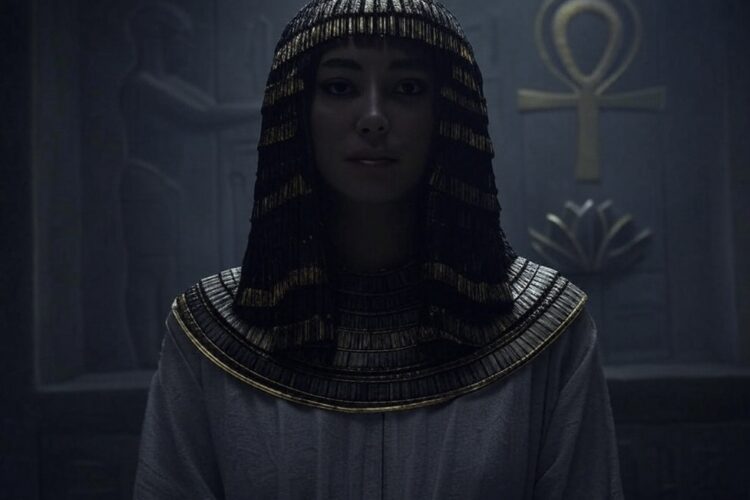Cleopatra’s tomb, lost for over 2,000 years, remains one of history’s great mysteries. Cleopatra VII, the last Ptolemaic pharaoh, ruled Egypt and died with Mark Antony in 30 BCE after losing to Octavian. Ancient texts say they were buried together near Alexandria, but earthquakes and rising seas may have submerged the site. Archaeologists also explore Taposiris Magna, a temple 30 miles west, where Kathleen Martinez has found coins, statues, and tunnels hinting at a royal tomb. Theories suggest it’s underwater, hidden under modern Alexandria, or moved by priests. Roman influence and time have obscured clues, but modern tools like sonar and radar fuel ongoing searches. The tomb promises treasures and insights into Cleopatra’s legacy—a brilliant leader whose resting place still eludes us.
Long Version
For over two millennia, the disappearance of Cleopatra’s tomb has captivated historians, archaeologists, and treasure hunters alike. Cleopatra VII, the last active ruler of the Ptolemaic dynasty, reigned over Egypt with unparalleled charisma and intellect, leaving an indelible mark on ancient history. Yet, despite endless searches, her final resting place remains one of archaeology’s greatest unsolved mysteries. From the submerged ruins of Alexandria to the remote Temple of Taposiris Magna, theories abound, but the tomb of this legendary pharaoh eludes discovery. This article delves into the historical context, the key players, the leading hypotheses, and the tireless efforts to uncover Cleopatra’s burial site, weaving together broad and niche insights into a comprehensive exploration of this enduring enigma.
Cleopatra VII: The Queen Behind the Mystery
Cleopatra VII Philopator, often simply known as Cleopatra, ascended to Egypt’s throne in 51 BCE at the age of 18. A descendant of the Greek Ptolemaic dynasty, she ruled during a tumultuous period marked by Roman influence and internal strife. Her alliances—and romantic entanglements—with Julius Caesar and Mark Antony solidified her power but also sealed her fate. Following her defeat by Octavian (later Emperor Augustus) at the Battle of Actium in 31 BCE, Cleopatra and Mark Antony took their own lives in 30 BCE. Ancient sources, including the Roman historian Plutarch, suggest that the lovers were buried together in a grand tomb befitting their status. Yet, the precise location of this necropolis remains lost to time.
The mystery begins with the lack of definitive records. Unlike earlier pharaohs whose tombs, adorned with hieroglyphs and alabaster statues, were built in the Valley of the Kings, Cleopatra’s burial reflects the hybrid Greco-Egyptian culture of the Ptolemaic era. Her tomb was likely constructed near Alexandria, her capital, but seismic activity, rising sea levels, and urban development have obscured the trail. For over 2,000 years, the question has lingered: Where is Cleopatra’s tomb?
Alexandria: A City Swallowed by the Sea
Alexandria, the bustling Mediterranean port founded by Alexander the Great, was Cleopatra’s seat of power. Ancient accounts describe a magnificent mausoleum where she and Mark Antony were interred, possibly adorned with treasures like canopic jars and golden artifacts. However, the city’s geography complicates the search. Over centuries, earthquakes and subsidence have submerged large portions of ancient Alexandria beneath the sea, transforming its once-grand streets into underwater ruins.
Archaeologists have long focused on this submerged necropolis, employing underwater archaeology to explore the harbor and nearby coastal sites. Discoveries like alabaster statues, sphinxes, and Ptolemaic-era relics hint at the city’s lost splendor, but Cleopatra’s tomb remains elusive. Some speculate that her burial site lies beneath the waves, its secrets guarded by the Mediterranean. The challenge of excavating these submerged ruins—coupled with modern development atop ancient layers—makes Alexandria a tantalizing yet frustrating focal point in the search.
Taposiris Magna: A Promising Alternative
Beyond Alexandria, another site has emerged as a leading contender: the Temple of Taposiris Magna, located about 30 miles west of the city. This ancient complex, dedicated to the goddess Isis (with whom Cleopatra identified), has drawn significant attention thanks to the work of Dominican archaeologist Kathleen Martinez. Since 2005, Martinez has spearheaded excavations here, arguing that Cleopatra chose this sacred site for her burial to align with her divine persona.
Excavations at Taposiris Magna have uncovered tantalizing clues: a necropolis with over 200 tombs, coins bearing Cleopatra’s likeness, and alabaster statues suggestive of royal significance. The discovery of a tunnel beneath the temple, stretching over 4,000 feet, has fueled speculation that it could lead to her mausoleum. Martinez posits that Cleopatra and Mark Antony were buried here to escape Octavian’s wrath, their tomb hidden to prevent desecration by Roman forces. While no definitive evidence has yet confirmed this theory, the site’s isolation and religious importance make it a compelling hypothesis.
The Role of Octavian and Roman Influence
Cleopatra’s death marked the end of Egyptian independence, with Octavian annexing the kingdom into the Roman Empire. His disdain for Cleopatra and Mark Antony raises questions about the tomb’s fate. Did he order its destruction or concealment? Roman records are suspiciously vague, noting only that the couple was buried with honor—a detail that contrasts with Octavian’s propaganda vilifying Cleopatra as a seductress. Some historians suggest he allowed a modest burial to avoid making her a martyr, while others believe the tomb’s grandeur was deliberately obscured to erase her legacy.
This Roman influence complicates the search. Unlike traditional Egyptian pharaohs, whose tombs were marked by pyramids and hieroglyphs, Cleopatra’s resting place may reflect a blend of Ptolemaic and Roman styles—less ostentatious yet still regal. The possibility that Octavian’s forces looted or relocated the tomb adds another layer of intrigue to its disappearance.
Theories and Speculation: Where Could It Be?
Beyond Alexandria and Taposiris Magna, several theories have emerged over the centuries:
- Submerged in the Harbor: The prevailing view holds that seismic activity sank Cleopatra’s tomb beneath Alexandria’s harbor. Underwater archaeology continues to probe this area, but murky waters and modern infrastructure hinder progress.
- A Hidden Chamber: Some propose the tomb lies beneath the modern city of Alexandria, perhaps in an undiscovered chamber sealed off by time. Urban sprawl makes large-scale excavation impractical, leaving this theory untested.
- Relocated by Priests: Another niche hypothesis suggests that priests of Isis moved Cleopatra’s remains to protect them from Roman plunder, possibly to a remote temple or necropolis now lost to history.
- Destroyed by Time: A less romantic possibility is that the tomb was destroyed—by natural disasters, looters, or construction—leaving no trace of its treasures or canopic jars.
Each theory underscores the challenges of pinpointing a site lost for over 2,000 years, with seismic activity, human intervention, and the passage of time as formidable adversaries.
The Search Continues: Modern Efforts and Insights
The quest for Cleopatra’s tomb is far from over. Kathleen Martinez’s work at Taposiris Magna has reinvigorated interest, blending rigorous archaeology with bold intuition. Meanwhile, advances in technology—such as sonar mapping of submerged ruins and ground-penetrating radar—offer new hope for discoveries in Alexandria and beyond. These efforts highlight the intersection of ancient history and modern science, as researchers strive to unlock Egypt’s secrets.
The tomb’s allure lies not just in its historical significance but in its promise of treasure: golden artifacts, hieroglyphic inscriptions, and perhaps even the mummified remains of Cleopatra and Mark Antony. Such a find would rewrite our understanding of the Ptolemaic dynasty’s final chapter and shed light on one of history’s most iconic figures.
Why It Matters: Cleopatra’s Legacy
Cleopatra’s tomb is more than a lost monument—it’s a symbol of her enduring legacy. As a woman who wielded power in a male-dominated world, she defied convention, blending Egyptian and Greek traditions to forge a unique identity. Her burial site, wherever it may be, represents the culmination of that story—a testament to her reign and her tragic end alongside Mark Antony.
The mystery also reflects broader themes in archaeology: the fragility of history, the resilience of human curiosity, and the tantalizing gaps in our knowledge. For over 2,000 years, the disappearance of Cleopatra’s tomb has defied endless searches, its secrets buried beneath sand, sea, or stone. Whether in the submerged ruins of Alexandria, the tunnels of Taposiris Magna, or an undiscovered corner of Egypt, the tomb remains a holy grail for explorers—a prize that promises to illuminate the past like never before.
Conclusion: An Unresolved Enigma
As of April 2025, Cleopatra’s tomb remains lost, its location a riddle wrapped in the sands of time. From the alabaster statues of Taposiris Magna to the underwater necropolis of Alexandria, each clue brings us closer, yet the ultimate discovery eludes us. Kathleen Martinez and her peers press on, driven by the hope that one day, the tomb of Cleopatra VII—queen, pharaoh, and legend—will emerge from obscurity. Until then, the search continues, a 2,000-year journey fueled by history’s most captivating mystery. What secrets lie within her mausoleum? Only time, and perhaps a stroke of luck, will tell.






